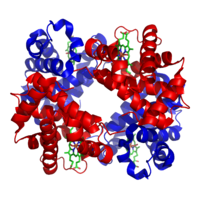
Photo from wikipedia
Electrochemical oxygen reduction could proceed via either 4e − -pathway toward maximum chemical-to-electric energy conversion or 2e − -pathway toward onsite H 2 O 2 production. Bulk Pt catalysts are… Click to show full abstract
Electrochemical oxygen reduction could proceed via either 4e − -pathway toward maximum chemical-to-electric energy conversion or 2e − -pathway toward onsite H 2 O 2 production. Bulk Pt catalysts are known as the best monometallic materials catalyzing O 2 -to-H 2 O conversion, however, controversies on the reduction product selectivity are noted for atomic dispersed Pt catalysts. Here, we prepare a series of carbon supported Pt single atom catalyst with varied neighboring dopants and Pt site densities to investigate the local coordination environment effect on branching oxygen reduction pathway. Manipulation of 2e − or 4e − reduction pathways is demonstrated through modification of the Pt coordination environment from Pt-C to Pt-N-C and Pt-S-C, giving rise to a controlled H 2 O 2 selectivity from 23.3% to 81.4% and a turnover frequency ratio of H 2 O 2 /H 2 O from 0.30 to 2.67 at 0.4 V versus reversible hydrogen electrode. Energetic analysis suggests both 2e − and 4e − pathways share a common intermediate of *OOH, Pt-C motif favors its dissociative reduction while Pt-S and Pt-N motifs prefer its direct protonation into H 2 O 2 . By taking the Pt-N-C catalyst as a stereotype, we further demonstrate that the maximum H 2 O 2 selectivity can be manipulated from 70 to 20% with increasing Pt site density, providing hints for regulating the stepwise oxygen reduction in different application scenarios. Controlling O 2 reduction pathways can help optimize catalytic activity and product selectivity. Here the authors report facile manipulation of 2e ‒ /4e ‒ pathways on Pt-coordinated motifs by varying the Pt site density or the coordination environment.
Journal Title: Nature Communications
Year Published: 2022
Link to full text (if available)
Share on Social Media: Sign Up to like & get
recommendations!